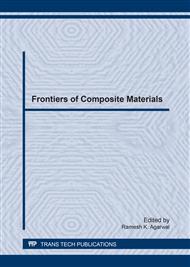[1]
E.R. Dustan. How Does Pozzolanic Reaction Make Concrete Green", (World of Coal Ash, WOCA, Denver, USA 2011).
Google Scholar
[2]
ACI Committee E-301, Cementitious Materials for Concrete (2015).
Google Scholar
[3]
A. Fauzi, M.F. Nuruddin, A. B. Malkawi, M. M. Al Bakri: Study of Fly Ash Characterization as a Cementitious Material. Procedia Engineering Vol 148 (2016) p.487–493.
DOI: 10.1016/j.proeng.2016.06.535
Google Scholar
[4]
P.E. Tsakiridis, G.D. Papadimitriou, S. Tsivilis, and C. Koroneos: Utilization of steel slag for Portland cement clinker production. Journal of Hazardous Materials Vol 152(2) (2008) pp.805-811.
DOI: 10.1016/j.jhazmat.2007.07.093
Google Scholar
[5]
A. B. Malkawi, M.F. Nuruddin, A. Fauzi, H. M. Almattarneh, B. S. Mohammed: Effects of Alkaline Solution on Properties of the HCFA Geopolymer Mortars. Procedia Engineering Vol 148 (2016) pp.710-717.
DOI: 10.1016/j.proeng.2016.06.581
Google Scholar
[6]
M.F. Nuruddin, A. B. Malkawi, A. Fauzi, B. S. Mohammed, H. M. Almattarneh: Geopolymer concrete for structural use: Recent findings and limitations. IOP Conference Series: Materials Science and Engineering Vol 133 (2016).
DOI: 10.1088/1757-899x/133/1/012021
Google Scholar
[7]
M.F. Nuruddin, A. B. Malkawi, A. Fauzi, B. S. Mohammed, H. M. Almattarneh: Evolution of geopolymer binders: a review. IOP Conference Series: Materials Science and Engineering Vol 133 (2016) p.012052, DOI: 10. 1088/1757-899X/133/1/012052.
DOI: 10.1088/1757-899x/133/1/012052
Google Scholar
[8]
T. Zhang, et al: Efficient Utilization of Cementitious Materials to Produce Sustainable Blended Cement. Cement & Concrete Composites Vol 34 (2012), pp.692-699.
DOI: 10.1016/j.cemconcomp.2012.02.004
Google Scholar
[9]
M. Maslehuddin, et al: Effect of Electric Arc Furnace Dust on the Properties of OPC and Blended Cement Concretes. Construction and Building Materials Vol. 25 (2011), pp.308-312.
DOI: 10.1016/j.conbuildmat.2010.06.024
Google Scholar
[10]
J.A. De Araújo, and V. Schalch: Recycling of Electric Arc Furnace (EAF) Dust for Use in Steel Making Process. Journal of Materials Research and Technology Vol. 3 (2014), pp.274-279.
DOI: 10.1016/j.jmrt.2014.06.003
Google Scholar
[11]
M. Thomas: The Effect of Supplementary Cementing Materials on Alkali-Silica Reaction: A review. Cement and Concrete Research Vol. 41 (2011), pp.1224-1231.
DOI: 10.1016/j.cemconres.2010.11.003
Google Scholar
[12]
ASTM C150/C150M, Standard Specification for Portland cement (2015).
Google Scholar
[13]
ASTM C1240, Standard Specification for Silica Fume Used in Cementitious Mixtures (2015).
Google Scholar
[14]
ASTM C618, Standard Specification for Coal Fly Ash and Raw or Calcined Natural Pozzolan for Use in Concrete (2012).
DOI: 10.1520/c0618-00
Google Scholar
[15]
ASTM C230/C230M, Standard Specification for Flow Table for Use in Tests of Hydraulic Cement (2013).
Google Scholar
[16]
ASTM C1202, Standard Test Method for Electrical Indication of Concrete's Ability to Resist Chloride Ion Penetration (2012).
Google Scholar


